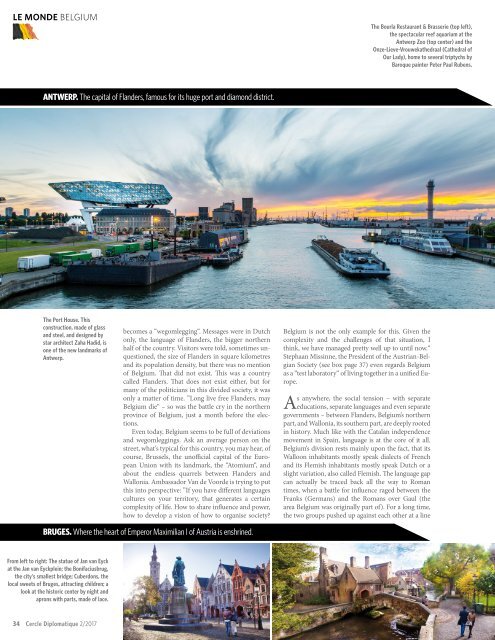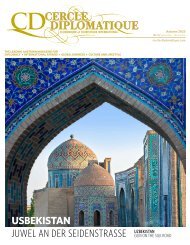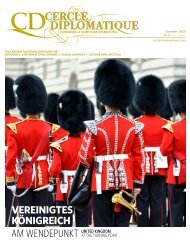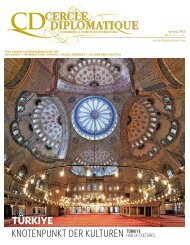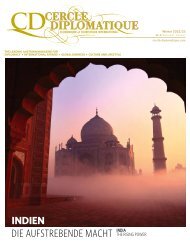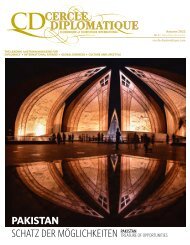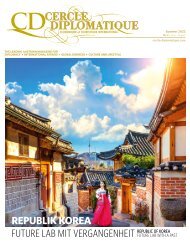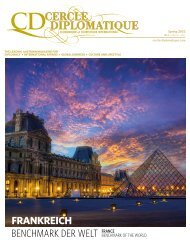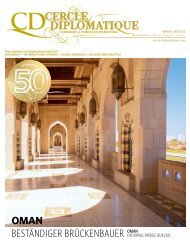CERCLE DIPLOMATIQUE - issue 02/2017
CD is a bi-lingual, independent and impartial magazine and is the medium of communication between foreign representatives of international and UN-organisations based in Vienna and the Austrian political classes, business, culture and tourism. CD features up-to-date information about and for the diplomatic corps, international organisations, society, politics, business, tourism, fashion and culture. Furthermore CD introduces the new ambassadors in Austria and informs about designations, awards and top-events. Interviews with leading personalities, country reports from all over the world and the presentation of Austria as a host country complement the wide range oft he magazine.
CD is a bi-lingual, independent and impartial magazine and is the medium of communication between foreign representatives of international and UN-organisations based in Vienna and the Austrian political classes, business, culture and tourism. CD features up-to-date information about and for the diplomatic corps, international organisations, society, politics, business, tourism, fashion and culture. Furthermore CD introduces the new ambassadors in Austria and informs about designations, awards and top-events. Interviews with leading personalities, country reports from all over the world and the presentation of Austria as a host country complement the wide range oft he magazine.
You also want an ePaper? Increase the reach of your titles
YUMPU automatically turns print PDFs into web optimized ePapers that Google loves.
LE MONDE BELGIUM<br />
The Bourla Restaurant & Brasserie (top left),<br />
the spectacular reef aquarium at the<br />
Antwerp Zoo (top center) and the<br />
Onze-Lieve-Vrouwekathedraal (Cathedral of<br />
Our Lady), home to several triptychs by<br />
Baroque painter Peter Paul Rubens.<br />
ANTWERP. The capital of Flanders, famous for its huge port and diamond district.<br />
FACTS &<br />
FIGURES<br />
The Port House. This<br />
construction, made of glass<br />
and steel, and designed by<br />
star architect Zaha Hadid, is<br />
one of the new landmarks of<br />
Antwerp.<br />
becomes a “wegomlegging“. Messages were in Dutch<br />
only, the language of Flanders, the bigger northern<br />
half of the country. Visitors were told, sometimes unquestioned,<br />
the size of Flanders in square kilometres<br />
and its population density, but there was no mention<br />
of Belgium. That did not exist. This was a country<br />
called Flanders. That does not exist either, but for<br />
many of the politicians in this divided society, it was<br />
only a matter of time. ”Long live free Flanders, may<br />
Belgium die“ – so was the battle cry in the northern<br />
province of Belgium, just a month before the elections.<br />
Even today, Belgium seems to be full of deviations<br />
and wegomleggings. Ask an average person on the<br />
street, what‘s typical for this country, you may hear, of<br />
course, Brussels, the unofficial capital of the European<br />
Union with its landmark, the “Atomium“, and<br />
about the endless quarrels between Flanders and<br />
Wallonia. Ambassador Van de Voorde is trying to put<br />
this into perspective: ”If you have different languages<br />
cultures on your territory, that generates a certain<br />
complexity of life. How to share influence and power,<br />
how to develop a vision of how to organise society?<br />
BRUGES. Where the heart of Emperor Maximilian I of Austria is enshrined.<br />
Belgium is not the only example for this. Given the<br />
complexity and the challenges of that situation, I<br />
think, we have managed pretty well up to until now.“<br />
Stephaan Missinne, the President of the Austrian-Belgian<br />
Society (see box page 37) even regards Belgium<br />
as a “test laboratory“ of living together in a unified Europe.<br />
As anywhere, the social tension – with separate<br />
educations, separate languages and even separate<br />
governments – between Flanders, Belgium’s northern<br />
part, and Wallonia, its southern part, are deeply rooted<br />
in history. Much like with the Catalan independence<br />
movement in Spain, language is at the core of it all.<br />
Belgium‘s division rests mainly upon the fact, that its<br />
Walloon inhabitants mostly speak dialects of French<br />
and its Flemish inhabitants mostly speak Dutch or a<br />
slight variation, also called Flemish. The language gap<br />
can actually be traced back all the way to Roman<br />
times, when a battle for influence raged between the<br />
Franks (Germans) and the Romans over Gaul (the<br />
area Belgium was originally part of). For a long time,<br />
the two groups pushed up against each other at a line<br />
PHOTOS: VISITFLANDERS.COM, MILO PROFI, ZOO ANTWERPEN, PETER KNOOP, KRIS JACOBS, JAN D‘HONDT, TOERIS-<br />
ME BRUGGE, MICHEL VAEREWIJCK, SARAH BLEE | NEUTELINGS RIEDIJK ARCHITECTEN, KRIS JACOBS<br />
The Museum aan de Strom.<br />
Literally, the museum by the<br />
river, certainly is one of the<br />
main attractions of the<br />
docks in Antwerp.<br />
formed naturally by connected forests, a line that<br />
roughly corresponds to the modern border between<br />
Flanders and Wallonia.<br />
When the tiny country of Belgium claimed its independence<br />
in 1830, after being occupied by about<br />
every large empire under the sun, including the<br />
Austrian Habsburgs, a Flemish movement was already<br />
on its way in trying to reverse the “enfrenchement“<br />
of the upper classes or beau monde of Belgian society,<br />
which had taken hold during the French rule in the<br />
18 th and 19 th centuries. Soon, the Dutch-speaking part<br />
of the population began fighting tooth and nail for<br />
equal status for their language, which was recognised<br />
as a state language alongside French, two years before<br />
the start of the 20 th century. Subsequently, Flanders<br />
outpaced Wallonia, which formerly had been the industrial<br />
heartland of Belgium, in economic growth<br />
and since the 1960s, official internal borders are dividing<br />
Belgium into four parts: Flanders, accounting for<br />
half of the population of some 11 million inhabitants,<br />
the roughly equally large Wallonia with a third of the<br />
population, the legally bilingual capital of Brussels,<br />
and the small region of East Cantons where German is<br />
spoken.<br />
Actually Brussels, a city of about two millions,<br />
home to the EU and the NATO, with tens of thousands<br />
of affluent foreign professionals and a large immigrant<br />
community, mainly with Turkish background<br />
and from Africa, is trying to make up the balance. But<br />
still, there are no national political parties, no national<br />
newspaper, no national TV channel, no common<br />
school curriculum or higher education. There is,<br />
however, the national debt, running at around 80 percent<br />
of GDP. So, like a couple trapped in a loveless<br />
marriage, eyeing divorce, but unable to agree on the<br />
mortgage liabilities, the Flemish and the Walloons, to<br />
outside observers, seem to be stuck together because<br />
of the cost of splitting up.<br />
Broadly speaking, the Walloons vote for the left,<br />
the Flemish for the right. Flanders is rich and prospering,<br />
contributes about 60 percent of Belgium‘s GDP<br />
of about 420 billion Euro (2016, nominal) and and its<br />
cities such as Antwerp – home to Europe‘s third-biggest<br />
port – are the beating heart of the country‘s economy.<br />
On the other hand, Wallonia – which was<br />
among the first regions in northern Europe to industrialise<br />
in the 19 th century, with industries such as<br />
glass making and coal mining – is nearly depressed,<br />
with twice the unemployment rate (more than 10<br />
percent) of the north, especially in the region‘s faded<br />
BELGIUM<br />
Official Name:<br />
Kingdom of Belgium<br />
Capital: Brussels<br />
Languages: Dutch, French,<br />
German<br />
Area: 30,528 sqkm 2<br />
Population: 11,250,585<br />
(2016 census)<br />
Parts of Country:<br />
Brussels (bilingual)<br />
East Cantons (German<br />
speaking)<br />
Flanders (Dutch speaking)<br />
Wallonia (French speaking)<br />
Currency: Euro (EUR)<br />
GDP: 470.179 billion $<br />
(nominal 2016)<br />
GDP per capita: 41,491 $<br />
(nominal 2016)<br />
Government: Federal<br />
parliamentary constitutional<br />
monarchy<br />
- Monarch: Philippe<br />
- Prime Minister:<br />
Charles Michel<br />
Formation:<br />
4 October 1830:<br />
Independence from the<br />
Netherlands declared.<br />
19 April 1839: Independence<br />
from the Netherlands<br />
recognised.<br />
1 January 1958: Founding<br />
Member of the European<br />
Union (formerly EEC).<br />
The famous fountain figure<br />
Manneken Pis in Brussels.<br />
From left to right: The statue of Jan van Eyck<br />
at the Jan van Eyckplein; the Bonifaciusbrug,<br />
the city‘s smallest bridge; Cuberdons, the<br />
local sweets of Bruges, attracting children; a<br />
look at the historic center by night and<br />
aprons with parts, made of lace.<br />
34<br />
Cercle Diplomatique 2/<strong>2017</strong><br />
Cercle Diplomatique 2/<strong>2017</strong><br />
35


